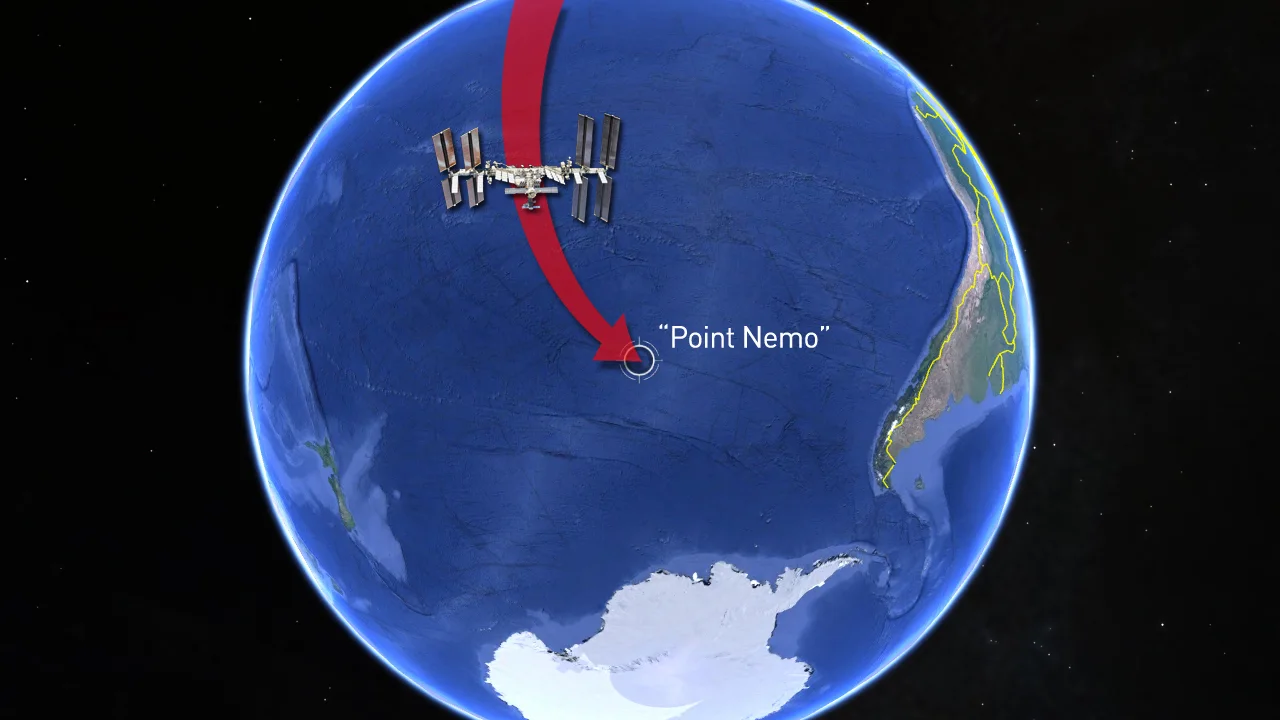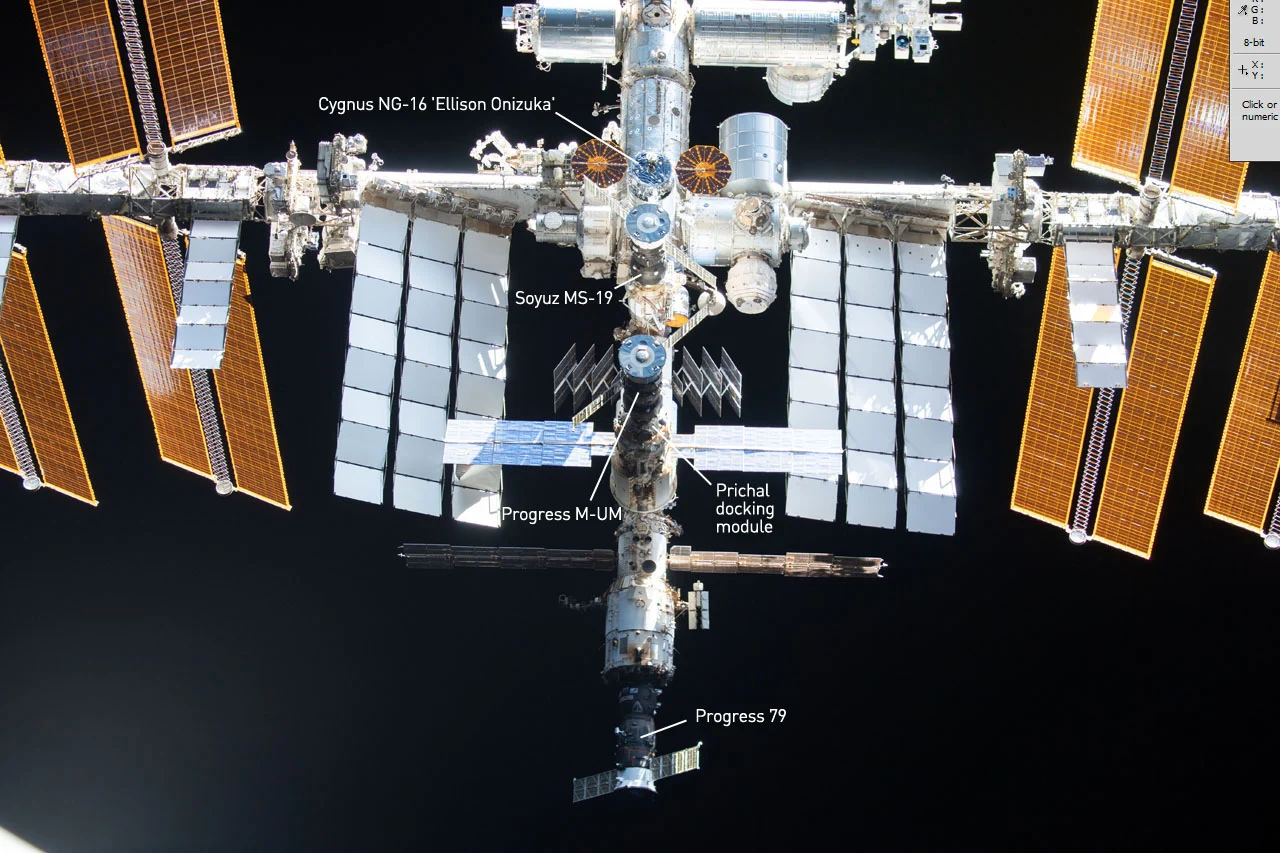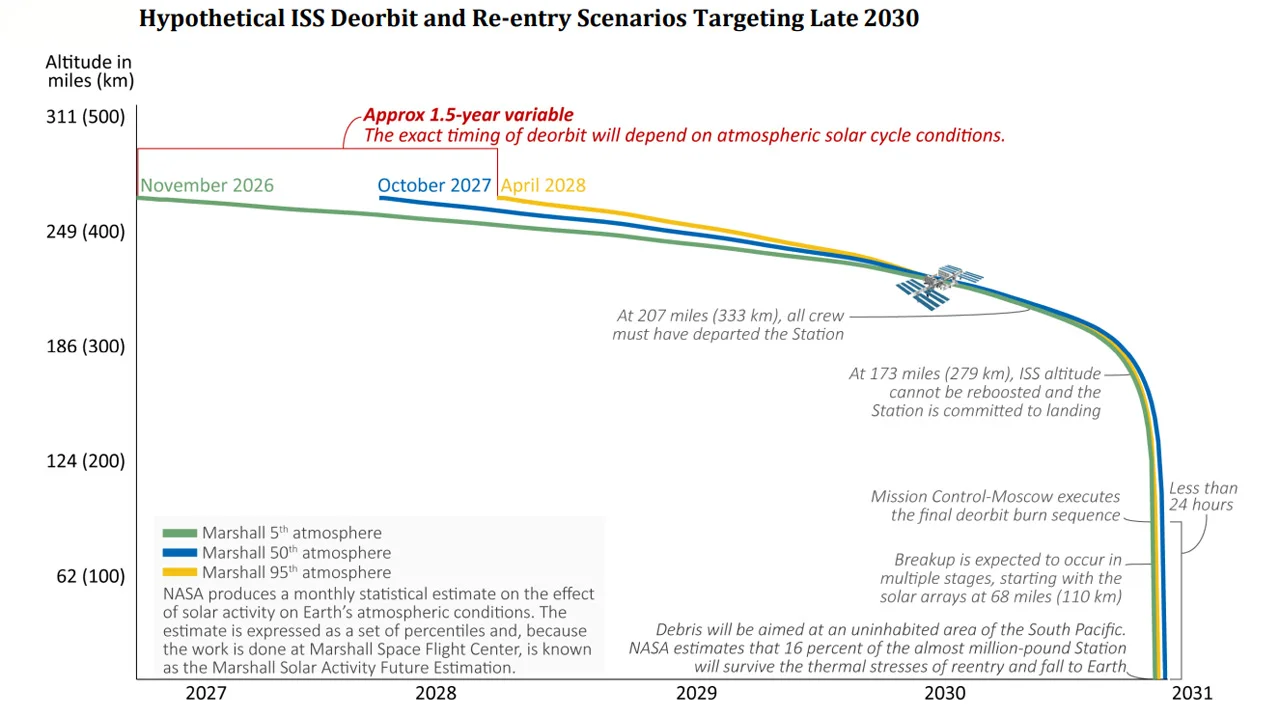
NASA plans to crash the ISS into the 'spacecraft cemetery' in 2031
The decommissioned orbital lab will join nearly 300 other defunct spacecraft under the waters of the South Pacific Ocean.
The International Space Station just got a new lease on life, as the Biden-Harris Administration extended the orbiting lab's operations until 2030. When that lease is up, the venerable station will be crashed down into a remote region of the South Pacific Ocean known as the spacecraft cemetery.
Point Nemo, in the South Pacific Ocean, is considered to be the most remote place on Earth. It lies roughly 4,700 km east of New Zealand, nearly 3,400 km west of southern Chile, and close to 2,700 km north of Antarctica. According to Hrvoje Lukatela, the Croatian-Canadian survey engineer who discovered it, it is also precisely 2,688 kilometres, 220 metres, and 58 centimetres from the closest islands to the south, north and northeast.

This Google Earth view of the South Pacific Ocean shows the location of Point Nemo. Credit: Google Earth/Scott Sutherland
This remoteness has earned Point Nemo another distinction. It is the centre point of the 'spacecraft cemetery', which contains the charred, broken remains of around 300 decommissioned space vehicles that have splashed down there since 1971.
Watch below: Space Graveyard - The place on earth where space missions go to die
WHAT GOES UP...
According to Shannon Stirone, in a 2016 article she wrote for Popular Science, up until that point, over 263 objects had splashed down in the spacecraft cemetery. This included the Russian space station Mir, plus six of their Salyut stations, as well as the remains of numerous satellites and spacecraft from various other countries, which managed to survive reentry into the atmosphere.
Over the past 5+ years, another 30 or so spacecraft have crashed down there after visiting the International Space Station. SpaceX's Cargo Dragon is the only delivery craft currently designed to survive reentry. They are used to return completed experiments or equipment being rotated out of use. The other cargo ships used to deliver supplies to the station — Russian Progress spacecraft, Japan's H-II Transfer Vehicle, and Northrop Grumman Space Systems Cygnus spacecraft — all burn up on reentry, with pieces of them shattering across the cemetery.

An image captured by astronauts on board Crew Dragon 'Endeavour' in November 2021 reveals the various cargo vessels and spacecraft attached to the International Space Station. Cygnus NG-16 'Ellison Onizuka' is closest to the top of the image (with the black and gold circular solar panels), Soyuz MS-19 is next in line, followed by Progress M-UM (which delivered the new Prichal docking module), and Progress 79 is attached to the end of the station. Credit: NASA
Now, this situation is not ideal, any way you look at it.
Leaving spacecraft in orbit indefinitely is not a great idea, even if that were possible. We have enough of a problem with space junk as it is, without leaving even more large objects circling our planet. There would be a greater chance of impacts, which would create even more debris, endangering both operational spacecraft and the lives of astronauts. This gradual buildup of orbital debris is known as Kessler Syndrome, portrayed in typical disaster-movie fashion in the 2013 film Gravity.
This problem is partly taken care of by Earth's atmosphere. Even as thin as the air is at an altitude of 300-400 km, it still exerts noticeable friction on spacecraft and debris. This slows these objects down, causing them to drop into a lower orbit. If left unchecked, they will eventually completely reenter the atmosphere. Increased solar activity speeds up this process since it causes the upper layers of the atmosphere to expand outward, thus producing more drag on orbiting objects. Spacecraft can extend their time in orbit by expending fuel to boost themselves higher up. Even so, fuel tanks eventually run dry. For others, such as cargo craft, there is no intention of keeping them in space.
Watch below: Two satellites in low-Earth orbit nearly collided in 2020!
When satellites and uncrewed spacecraft reach the end of their mission, those still under our control are specifically aimed to crash into the spacecraft cemetery to minimize the threat to human life. These objects tend to be designed to be as lightweight as possible, so they mostly burn to ash as they plunge into the atmosphere. Some pieces, such as fuel tanks, still survive to reach the surface, though. As a result, there's an environmental impact to this. However, it's difficult to know the full extent of this impact because there's no way to be sure exactly how much of a spacecraft actually survived reentry.
THE FUTURE OF THE ISS

The International Space Station. Credit: NASA/Wikimedia Commons
The first pieces of the International Space Station were launched in 1998, and the station has developed and expanded over the past 24 years. The plan has always been to crash it down into the spacecraft cemetery. The part that has changed over the years is when that will happen. As of 2014, the expected 'end of mission' for the ISS was in 2024. Now, it has been extended until 2030.
The ISS is definitely showing the signs of its age. However, according to a new NASA report, the agency expects that they will be able to maintain the station throughout the rest of this decade. Additionally, there is the expectation that private space stations will be built in the years ahead, which can then serve in the same capacity as the ISS.
"The private sector is technically and financially capable of developing and operating commercial low-Earth orbit destinations, with NASA's assistance. We look forward to sharing our lessons learned and operations experience with the private sector to help them develop safe, reliable, and cost-effective destinations in space," Phil McAlister, director of commercial space at NASA Headquarters, said in a statement.
As these new commercial space stations come online, NASA will seek to become a customer of those ventures to continue the research currently conducted in orbit.
"The report we have delivered to Congress describes, in detail, our comprehensive plan for ensuring a smooth transition to commercial destinations after retirement of the International Space Station in 2030," McAlister said.
With the plan to now decommission the orbital lab in 2030, the report states that the splashdown of the ISS in the spacecraft cemetery would be completed by January of 2031.

This graph from a November 2021 report plots the estimated timing for reentry of the International Space Station in early 2031. The three lines of the graph — green, blue, and yellow — represent estimates of when they would begin lowering the station's orbit, based on upper atmospheric drag due to solar activity (weakest, average, and strongest, respectively). Credit: NASA
There is still a chance that NASA and Congress will decide to extend the International Space Station's time in orbit again. This will likely depend on the continued health of the station, upgrades of the equipment and possible expansion via additional modules, financial commitments from the member states, and so forth. As of now, though, it looks like the ISS will only be around, and a part of our night sky, for the next 8 years.











